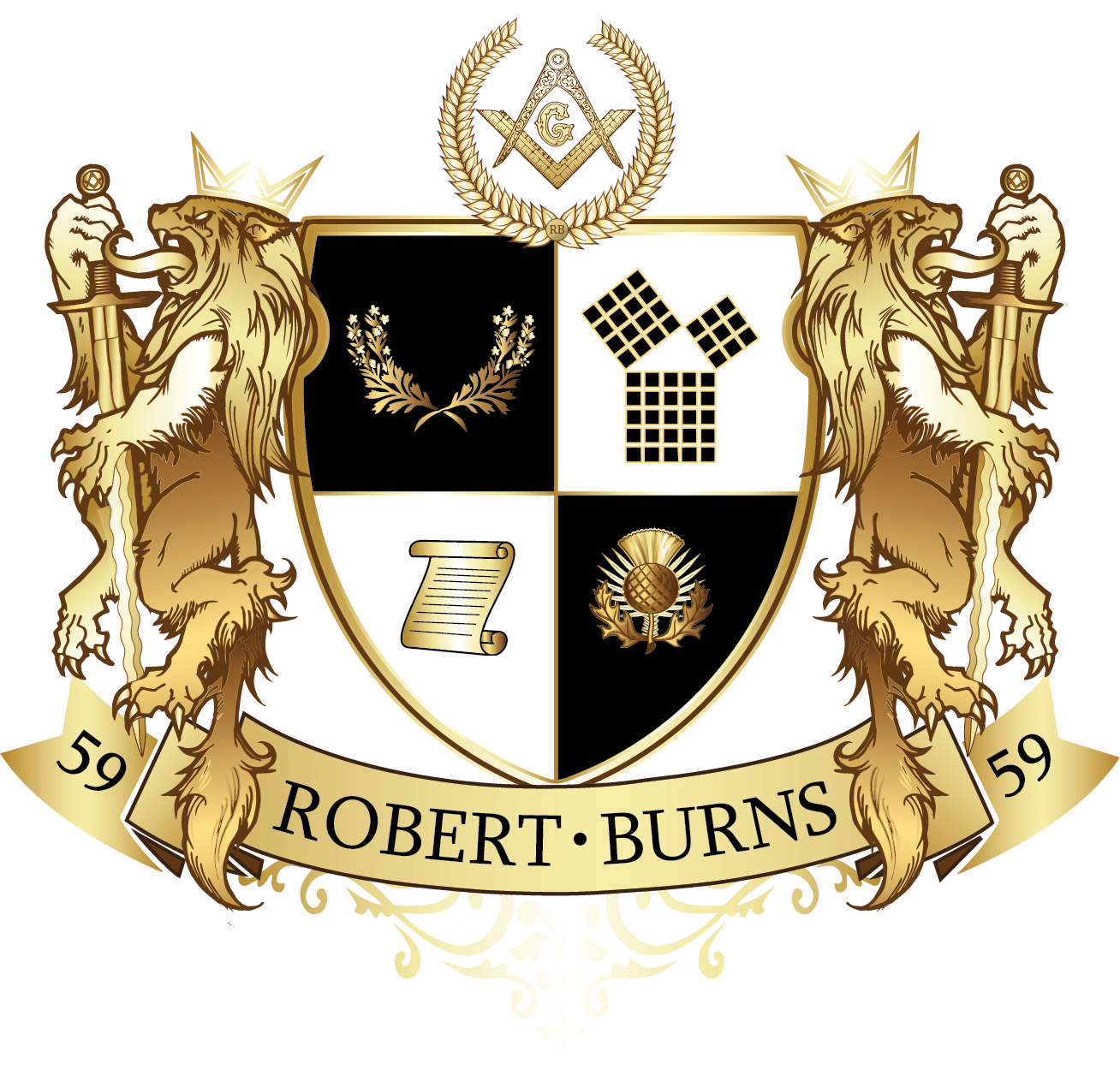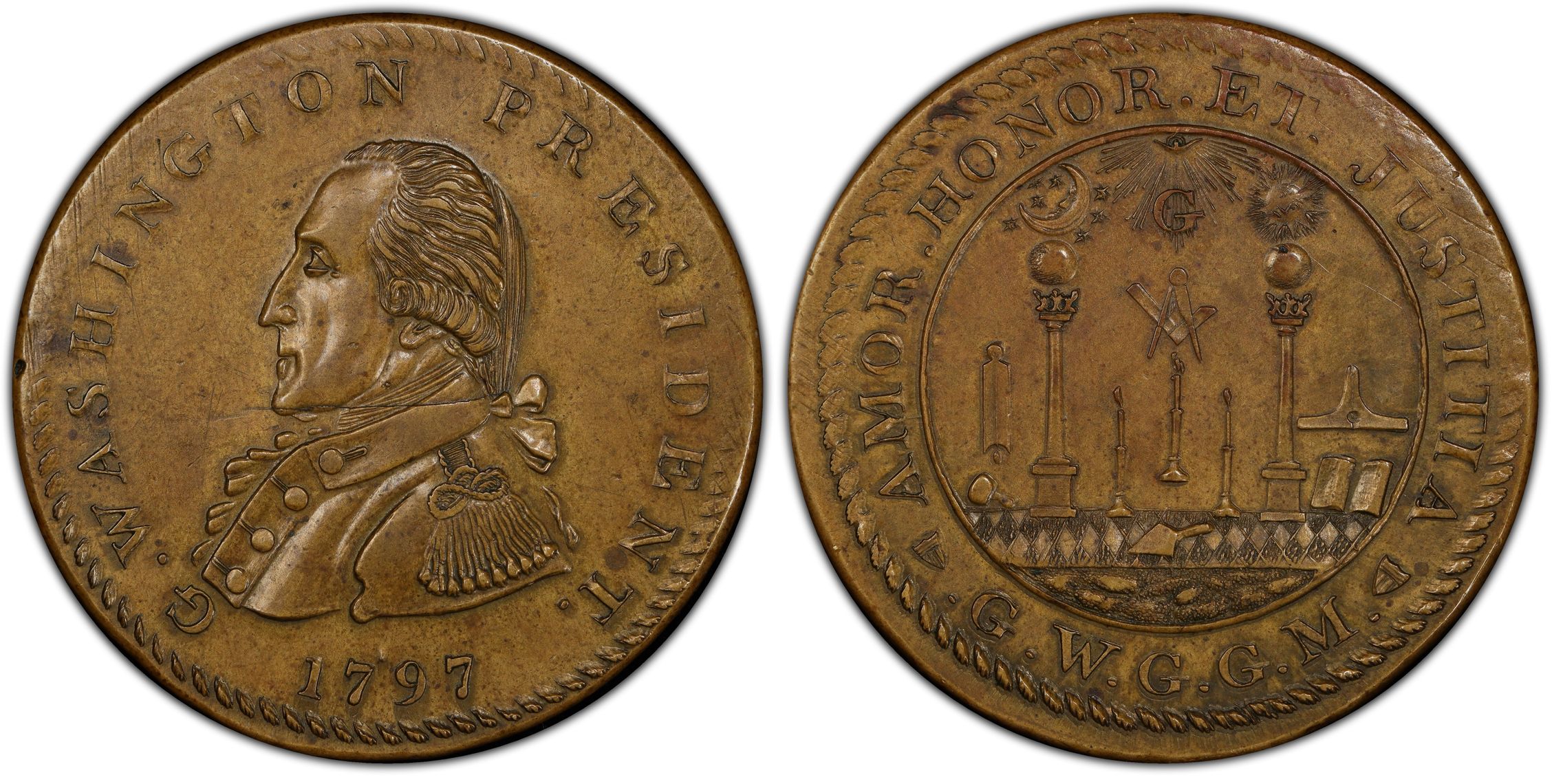The Lost Washington Masonic Relic of 1797


In the secret archives of masonic history lies a treasure of incomparable significance – a brass medallion bearing the likeness of our nation's first President and distinguished Brother, George Washington. This rare artifact, the 1797 George Washington General Grand Master Masonic Medal, represents not merely a numismatic curiosity but a tangible connection to the earliest days of American Freemasonry and the man who helped shape a nation.
A Medal of Extraordinary Craftsmanship
Measuring 36.0 mm x 35.6 mm and weighing 258.4 grains, this medallion stands as one of the most spectacular surviving specimens of a notable rarity. Struck on a slightly oversized and not quite round planchet, it displays superb sharpness and incomparable aesthetic appeal on both sides. The surfaces remain smooth and glossy, with traces of golden luster amidst the even golden honey tan surfaces – a testament to centuries of careful handling by those who recognized its significance.
The impressive relief of the portrait was brought up with two strikes, and slight doubling is noted primarily at the base of the reverse. Though the peripheries are a bit soft in areas, leaving pre-striking file marks on the handmade planchet visible near 9 o'clock on the obverse and to a lesser extent at 3 o'clock, the full border is struck up and bold at the base of the obverse and around most of the reverse. Only the upper right quadrant of the reverse is not quite fully realized.
What makes this specimen particularly exceptional is the crispness of the central motifs, including the fine facial details on the sun and moon at the central reverse. The area opposite the highest relief of the obverse portrait – which typically shows the softest strike affecting the square and compass at central reverse – is especially crisp on this remarkable example.
Pristine Condition Through the Centuries
The exceptional preservation of this medal speaks volumes about the reverence with which it has been handled through the centuries. No notable post-striking flaws are seen, with only a very light hairline scratch right of the right pillar at central reverse. A tiny pit above the H of WASHINGTON is inherent in the planchet, and most of the few subtle darker areas (visible at some angles, invisible at others) are likewise natural in the brass rather than later corrosive byproducts.
The medal was struck from an advanced state of the obverse die, as evidenced by the horizontal die crack from the field beneath AS across the tip of Washington's chin to the knot of his peruke – a feature often seen on these medals. A tiny, raised knob rising from the field above the space between 79 in the date is a die injury and is as struck.
"Perhaps no other medal struck during Washington's lifetime so captures the personal Washington – the man, the Mason – as this rare medal, a prize that only a half dozen or so collectors can ever hope to own simultaneously."
The Symbolic Design
The obverse features a dignified portrait of Washington with the simple inscription "WASHINGTON PRESIDENT." The reverse reveals the true purpose of the medal, displaying the working tools and symbols of a Masonic Lodge, with the initials "GWGGM" at the bottom – standing for "George Washington General Grand Master."
These symbols would be instantly recognizable to any Brother – the square and compass, the pillars of wisdom, strength, and beauty, the all-seeing eye, the sun and moon, and other emblems of the Craft. Together, they formed a powerful statement about Washington's connection to Freemasonry and his esteemed position within the brotherhood.
A Promotional Purpose
What makes this medallion particularly intriguing is its historical context. Struck in 1797 as Washington's presidency concluded, it served a promotional purpose, advocating for the election of Brother Washington as General Grand Master of Masons in America. This represents one of several campaigns to organize a general Grand Lodge – all of which ultimately failed.
The medal thus stands as a physical reminder of an alternative history that might have been – had Washington accepted this proposed position, the structure of American Freemasonry might have evolved quite differently. Instead, the American system developed with sovereign Grand Lodges in each state, a system that continues to this day.
A Rarity Among Rarities
This medal belongs to a rare class indeed. While most examples exist in brass, only one silver example is confirmed (an engrailed edge specimen ex Ellsworth-Garrett IV:1837). A well-worn plain edge specimen, ex Mickley, was described in the 1882 Bushnell sale but has not been traced. Another rumored silver specimen, once part of a silver-plated ladle held by a Virginia Masonic lodge, had never been examined by numismatists prior to its disappearance and could prove to be either silver or silverplate.
What makes the specimen described here even more extraordinary is that it is the only known example with a plain edge, a fact noted by the Chapman Brothers when they sold this medal in 1904 – a distinction that appears to remain true today. There is also a small number of uniface obverses, and unique white metal die trials (one two-sided and one uniface) in the collection of the Masonic Grand Lodge of Massachusetts.
Among the Finest Known
This specimen easily ranks among the very finest known examples of this rarity, far higher than the rank of sixth finest given it by numismatic researcher Fuld, who only had the benefit of the plate from this medal's last auction appearance in 1925. The two specimens listed atop Fuld's census are in similar grade, and on any particular day an experienced collector could deem any one of them the finest.
The Baker specimen, sold in 2019 graded EF Details–Environmental Damage (PCGS), is ranked third in the Fuld listing. Current census data suggests there are only about seven examples in this composition in private hands, plus the confirmed silver specimen and a unique overstrike. Between eight and ten additional specimens rest in institutional collections, with almost all showing significant wear.
A Journey Through Time and Notable Collections
The provenance of this medal reads like a who's who of distinguished collectors:
- From New York Stamp and Coin Company's sale of the Robert Coulton Davis Collection, January 1890, lot 277
- Samuel Hudson and Henry Chapman's sale of the Ralph R. Barker Collection, July 1904, lot 426
- Samuel Hudson Chapman's sale of the Henry Jewett Collection, June 1909, lot 405
- Henry Chapman
- Wayte Raymond's sale of the W.W.C. Wilson Collection, November 1925, lot 856
- Col. E.H.R. Green Collection
- Col. E.H.R. Green estate to Burdette G. Johnson, via Eric P. Newman
- Burdette G. Johnson Estate to Mary Hedgcock Sheffield, 1948
- Unknown collector intermediary
- New England estate sale, 2021
After the W.W.C. Wilson sale of 1925, the medal disappeared from public view for nearly a century before its dramatic reappearance at a New England estate sale in 2021. At some point before the W.W.C. Wilson sale, this medal's provenance was conflated or confused with that of the Stickney specimen, which later joined the Ted Craige and Alan Weinberg collections.
The Mystery of Creation and Attribution
While masonic tradition has long attributed these medals to Peter Getz of Lancaster, a silversmith who created the 1792 private patterns with Washington's portrait, the connection remains undocumented. The portrait on this medal is not a precise match for those found on the 1792 private patterns, but it is either by the same hand or, quite possibly, a copyist's attempt.
The detail on the epaulet is quite different, but otherwise the portrait plainly copies the 1792 pieces by Getz. As a skilled mason who served as master of his local lodge in 1794, and as an active die engraver in this era, Getz remains a plausible candidate for the medal's creation – though numismatic researcher Neil Musante suggested in his "Medallic Washington" that this medal was probably not by Getz.
An intriguing clue emerged from an unexpected source: a manuscript from the archives of the descendants of Adam Eckfeldt, which hit the market in 2014. Entitled "An inventory of Coining Machines taken from Richard Harpers & sent to the Mint of United States by order of the Mayor of this City Aug. 29th, 1797," this document may hold the key to the medal's origin.
Researchers believe Richard Harper was the son of the recently deceased minter and sawmaker John Harper of Philadelphia, who died in either late 1796 or early 1797. The inventory lists a coining press, cutting press, rolling press, and most everything else needed to operate a private mint. Most significantly, it includes "2 Dies of General Washington Heads" and "1 [die] of the face Masons coat of Arms" – seemingly describing the very dies used to strike this medal.
This suggests that John Harper, known for producing the "Jefferson Head" cents of 1795, may have been involved in the production of these Masonic medals – though whether he was the engraver or simply the coiner working from dies by Getz or another artist remains uncertain.
Historical Context Among Washington Medals
There are other earlier Washington medals; the Paris-made Voltaire medal ranks first chronologically. There are even earlier American-made Washington medals, namely the Manly medals of 1790. But perhaps no other medal struck during Washington's lifetime so genuinely captures the personal Washington – the man, the Mason – as this rare medal.
It represents a unique moment in American and masonic history when the most revered figure in the new nation was also a practicing Brother. Washington's masonic affiliations are well-documented; he was initiated as an Entered Apprentice in Fredericksburg Lodge No. 4 in Virginia on November 4, 1752, passed to Fellow Craft on March 3, 1753, and raised to Master Mason on August 4, 1753.
Throughout his life, Washington maintained connections with the Craft, participating in masonic ceremonies including the laying of the cornerstone of the United States Capitol on September 18, 1793. This medal, struck just as his presidency concluded, represents an important physical link to this dual legacy.
The Medal's Significance Today
For collectors, this medal represents an extraordinary prize – one that only a half dozen or so collectors can ever hope to own simultaneously. For Freemasons, it offers a tangible connection to one of the most distinguished Brothers in American history and a reminder of the Craft's deep roots in the founding of the nation.
The re-emergence of this specific example after nearly a century in obscurity reminds us that historical treasures sometimes disappear only to return when the time is right. As this remarkable medal passed through the hands of some of the most notable numismatists and collectors of the past century and a half, it carried with it not just the likeness of Washington but the story of American Freemasonry itself.
As we reflect on this long-lost relic, we are reminded that the bonds of brotherhood extend beyond time itself, connecting us to the very foundations of our craft in America and to one of its most distinguished practitioners – our Brother, George Washington.
By Antony R.B. Augay P∴M∴
For Robert Burns Lodge 59, F∴& A∴M∴ of Nevada
